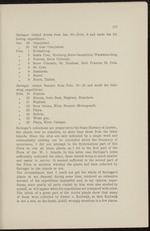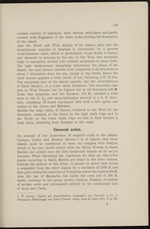| 1 |
 |
“...did in the first part of the
Flora of the W. I. Islands. In this latter case Suringar’s notes
sufficiently indicated the place, these islands being so much smaller
and easier to survey. It seemed sufficient in the second part of
the Flora to mention whether the plants had been collected by
Suringar in the islands or not.
The circumstance that I could not get the whole of Suringar’s
plants at my disposal during some time, rendered an extensive
account of his expeditions impossible and, in my opinion, super-
fluous, since nearly all parts visited by him were also studied by
myself, as will appear when his expeditions are compared with mine.
The labels of a great part of the Aruba plants show that many
of them were collected by Pastor v. Koolwijk, so that Koolwijk
is not a site, as the Symb. Antill. wrongly mentions in a few places....”
|
|
| 2 |
 |
“...mountainranges proceed in a S. E. direc-
tion, consisting of round cup-shaped hills with a few apices and
ending in the Joewa and Makakoe.
Besides the large valley of Rincon, bordered to the West by the
Brandaris complex, to the South by the high chalk ridge and to
the North by the lower chalk ridge we find in East Bonaire a
large plain, extending from Karakao to the coast.
General notes.
On account of the occurrence of eruptive rocks in the islands
Curasao, Aruba and Bonaire Sieversx) is of opinion that these
islands must be considered to form one complex with Goajira,
which in its turn would cohere with the Sierra Neveda de Santa
Martha and extend over the first mentioned islands as far as Los
Rocques. When discussing the vegetation we shall see that a few
plants occurring in Santa Martha are found in the three islands,
forming the subject of this Flora. It should be noted that Aruba
is separated from the other islands by a sea-depth of 2000 M. and
falls quite within the coast line of...”
|
|
